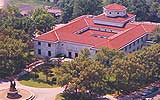Faculty
Gao Minglu
“I don’t like academic play,” says Gao Minglu. That sensibility stems from what he’s seen in the 20 years characterizing the avant-garde art movement in his native China, during times that have been anything but academic.
As editor of China’s leading art journal Meishu in the 1980s, Gao was a key figure in reporting on the art explosion he dubbed The ’85 Movement. In 1989 he curated the China/Avant-Garde Exhibition at the National Art Gallery in Beijing, but saw it shut down before it could open when an artist completing her installation fired an unlicensed gun. After 1989’s Tiananmen Square crackdown, Gao was placed on involuntary leave from his job and watched with dismay as the art movement split into “political/cynical realism” and a deep underground avant-garde he labeled “apartment art.”
After leaving China in 1991, he became a leading researcher, writer, and authority of 20th century East Asian art. Gao curated 1998’s Inside Out: New Chinese Art, then the largest exhibition of modern art from his country. In 2005 he organized The Wall: Reshaping Contemporary Chinese Art, a collaboration of the Albright-Knox Art Gallery, the China Millennium Monument Museum in Beijing, and the University at Buffalo Art Galleries. The New York Times described it as “a thought-provoking exhibition that explores the many walls - physical and metaphorical - that unite and divide Chinese society.”
“It’s not just about a physical wall,” Gao says of the project. “My goal is to find the boundaries shaping and fragmenting Chinese modernity.”
In today’s booming China, walls go down and up. “The old districts are just destroyed, replaced by newer structures. But how is that changing the social structures?” For one thing, modernization is forcing artists to abandon their traditional urban enclaves for spaces on the borders between the old and the new, or in the countryside.
Globalization has also built and destroyed barriers, opening international markets to Chinese artists while defining boundaries within; for instance, Western feminism and its impact on Chinese female artists is depicted on The Wall.
Gao tries to reconcile his training in Chinese art and Western theory. “The avant-garde in the West has been related to modernity. In China, political and artistic currents interact more strongly. Along with its Zen Buddhist underpinnings, Chinese art has been shaped by socialist realism, Maoism, Tiananmen, and industrialization, creating something distinct that Gao characterizes in his 2003 book Chinese Maximalism.
“The Chinese art historians always use a lot of Western terms and Western theory to examine local art,” Gao says. Since Western theory doesn’t adequately account for Chinese traditions, interaction with Japan and Korea, or the tumult of the last half century, Gao seeks “a way that particularly fits Chinese and East Asian contemporary art history … a way to really close the gap between the text and the context.”
